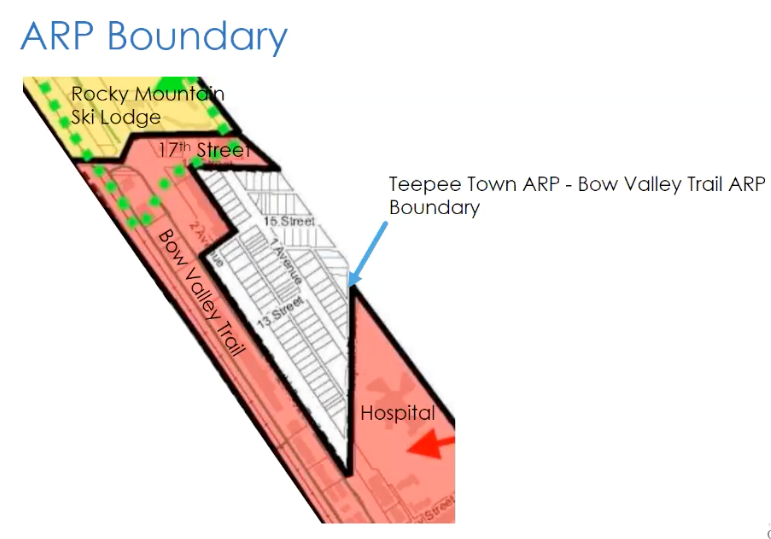CANMORE – After members of the public expressed concerns about changes to the Teepee Town redevelopment plan, Canmore's elected officials took time to try and address the issues raised before it passed third reading.
The Teepee Town Area Redevelopment Plan (ARP) was in front of council June 2 for a public hearing, after first reading was approved by earlier this spring.
Originally adopted in 2005, the ARP sets out the parameters under which redevelopment within the area can occur in terms of permitted and discretionary uses, setbacks and building heights, for example.
Changes drafted in collaboration with a task force made up of residents of the area put forward included expanding the area along Second Avenue zoned for mixed use and required commercial on the ground floor.
That requirement for commercial, similar to the zoning for ground floor development in other mixed use areas like Bow Valley Trail, and the gateway district, was challenged by residents, prompting Mayor John Borrowman put forward an amendment to remove that new regulation.
"To some extent this is in response to the input from residents of Teepee Town who have requested the possibility for residential on the ground floor continue to be permitted," Borrowman said.
While the intent of the change is to see the streetscape along Second Avenue include more small business operations, the mayor said he would prefer to leave it up to property owners to decide.
"I have confidence in residents and the future," Borrowman said. "I can see a future streetscape there that does contain mixed-use shops on the ground floor."
During the public hearing, Phil Richards questioned the change, saying it is forcing commercial redevelopment on property owners after a portion of the street has already redeveloped with residential on the ground floor.
"At this stage, a significant portion of properties have already been [redeveloped] and this change to force commercial development does not make sense given what has already occurred," Richards said. "I strongly encourage council to change [this]."
While the rest of council supported the mayor's amendment, several councillors spoke in favour of what the proposed change would achieve into the future.
"By giving an option, it is easier to just build the residential and leave the commercial behind," said Coun. Vi Sandford. "I am kind of torn about facilitating more residential when what has to be relinquished is the opportunity for commercial because the choice is easier to go in one direction."
Coun. Joanna McCallum, who is the council representative on the Teepee Town task force, said the vision for the future of the area is a vibrant, walkable community.
"I think Teepee Town has the potential of being Sesame Street," she said. "I know that might sound silly, but it is that ability to have a nice enclosed neighbourhood that is able to take care of its own residents with its own services, and that is why I would like to see more commercial come forward in Teepee Town."
McCallum added that one reason Second Avenue has not seen as much commercial development as the municipality and elected officials would have liked to see, is that building commercial is somewhat disadvantageous when compared to residential.
"It requires commitment," she said. "But as much as I would like to see what is stated in the draft move forward, I also know there seems to be a lot of fear and pressure from development in general.
"I will support this [amendment], but I am not sure it will get us what we are looking for."
Coun. Karen Marra said she supports giving property owners the choice.
"It shows we listened to the community," she said.
Development planner Nathan Grivell said the objective of updating the bylaw is to create a policy focused and user friendly document that ensures the efficient use of land, increases housing opportunities and update the framework for the areas transportation network to align with the municipality's integrated transportation plan.
"With regards to ensuring efficient use of land, the ARP has been updated with a new land use concept that has increased the residential density by up to 187 residential units and expanded the mixed use area, with a new requirement for at grade commercial development," Grivell said.
He said the fact that only one lot along Second Avenue has been redeveloped with commercial on the ground floor speaks to the fact that residential development is the preferred choice. Grivell said the change proposed by administration would lead to a different housing option of residential on the second floor, versus more fourplexes.
Manager of planning and development Lauren Miller said the change proposed would not spark a significant shift to decimate the character of Teepee Town, but create a more complete neighbourhood with vibrant streets and places to gather.
"We can see what market forces produce and without policy direction, the current pattern will continue to be the prevailing pattern," Miller said.
Bow Valley Builders and Developers Association president Ron Remple said during the public hearing that the original ARP created different rules that made it more difficult for development to occur as a result.
While the new ARP is an improvement, there are a number of issues Remple said the industry has raised. However, he said the expectation is those will be dealt with during the next phase of the Land Use Bylaw rewrite in that legislation's regulations.
"In summary, the proposed area redevelopment plan is an improvement upon the exiting one," he said. "But the devil is in the details of the regulation. We look forward to seeing those and ensuring the issues we addressed are done in the Land Use Bylaw."




